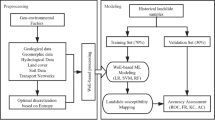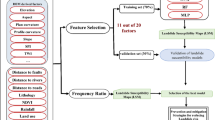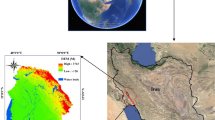Abstract
Accurate assessment on serious geological hazards using artificial intelligence is required in geological hazards assessment with aim to improve the efficiency and accuracy of karst geological hazard identification. In this paper, topography and geology characteristics are selected as susceptibility factors for geological disasters identification. The area of Guibei, Guangxi Province, was selected as the study area because of its typical karst landform. Intelligent classification of influential factors for karst geological hazard identification is realized by utilization of support vector machine, meanwhile, the cloud model theory was introduced and a comprehensive method of susceptibility zoning deployment of geological hazards in karst areas was proposed, further, a quantitative susceptibility assessment model for unsuitable geology in karst areas was established. After that, a comprehensive geological hazard susceptibility index (S) proposed in this paper is calculated with assistance of machine learning theory in the proposed model. The results show that the influential factors can be divided into five grades through statistical learning, the susceptibility index of geological hazards in the study area is between 0.713 and 5.798, the susceptibility of geological hazards in the mid-section take the largest share. Differences in the distribution of high, middle, and low susceptibility zones are significant. Different susceptibility zoning have different influence on engineering construction.



Similar content being viewed by others
References
Choubin, B., Darabi, H., Rahmati, O., et al.: River suspended sediment modelling using the CART model: a comparative study of machinelearning techniques. Sci. Total Environ. 615(2), 272–281 (2018)
Chapi, K., Singh, V., Shirzadi, A., et al.: A novel hybrid artificial intelligence approach for flood susceptibility assessment. Environ. Model. Softw. 95(9), 229–245 (2017)
Johannes, M., Jakob, T., Michael, F., et al.: Learning from the crowd: Road infrastructure monitoring system. J. Traffic Transp. Eng. 4(5), 451–463 (2017)
Waele, J., Gutierrez, F., Audra, P.: Karst geomorphology: from hydrological functioning to palaeoenviron mental reconstructions. Geomorphology 229(229), 1–2 (2015)
Zhou, W., Beck, B.F., Adams, A.L.: Application of matrix analysis in delineating sinkhole risk areas along highway (I-70 near Frederick, Maryland). Environ. Geol. 44(7), 834–842 (2003)
Boni, M., Rollinson, G., Mondillo, N., et al.: Quantitative mineralogical characterization of karst bauxite deposits in the southern Apennines, Italy. Econ. Geol. 108(4), 813–833 (2013)
Bautista, F., Palacio-Aponte, G., Quintana, P., et al.: Spatial distribution and development of soils in tropical karst areas from the Peninsula of Yucatan, Mexico. Geomorphology 135(3), 308–321 (2011)
Mylroie, J.E., Carew, J.L.: Karst development on carbonate islands. Speleogenesis Evol. Karst Aquifers 1(2), 1–21 (2003)
Vesper, R.: Water in karst: management, vulnerability, and restoration. Groundwater 51(5), 656–656 (2013)
Parise, M., Closson, D., Gutiérrez, F., et al.: Anticipating and managing engineering problems in the complex karst environment. Environ. Earth Sci. 74(12), 7823–7835 (2015)
Zhang, Z.L.: Study on karst development pattern of Qianjiang–Zhangjiajie–Changde railway. Railw. Stand. Des. 12, 15–18 (2013)
Shen, Z.P., Sun, H., Wu, B., et al.: Study on typical geologic hazard in karst depressions and its countermeasures. Chin. J. Geol. Hazard Control 27(2), 137–144 (2016)
Nichol, J.E., Shaker, A., Wong, M.S.: Application of high-resolution stereo satellite images to detailed landslide hazard assessment. Geomorphology 76(1), 68–75 (2006)
Tang, C., Zhu, D.K.: Assessment of debris flow risk of Yunnan province by using GIS. Sci. Geogr. Sin. 22(3), 300–304 (2002)
Huang, X.T.: Safety inspection and risk evaluation of geological disasters of high slopes of expressways. Technol. Highw. Transp. 2, 8–11 (2012)
Martinotti, M.E., Pisano, L., Marchesini, l, et al.: Landslides, floods and sinkholes in a karst environment: the 1–6 September 2014 Gargano event, southern Italy. Natu. Hazards Earth Syst. Sci. 17(3), 467–480 (2017)
Qi, H.L., Tian, W.P., Li, J.C.: Regional risk evaluation of flood disasters for the trunk-highway in Shaanxi, China. Int. J. Environ. Res. Public Health 12(11), 13861–13870 (2015)
Jia, X.L., Xu, J.L.: Cloud model-based seismic risk assessment of road in earthquake region. J. Tongji Univ. 42(9), 1352–1358, 1458 (2014)
Dai, J.L., Lei, M.T.: Study on the risk assessment on karst collapse in linear engineering. Carsol. Sin. 31(3), 296–302 (2012)
Li, S.C., Wu, J., Xu, Z.H., et al.: Unascertained measure model of water and mud inrush risk evaluation in karst tunnels and its engineering application. Ksce J. Civ. Eng. 21(4), 1170–1182 (2017)
Xu, Z.H., Li, S.C., et al.: Risk assessment of water or mud inrush of karst tunnels based on analytic hierarchy process. Rock Soil Mech. 32(6), 1757–1766 (2011)
Jia, X.L., Xu, J.L., Yang, H.Z., et al.: Calculation of broken index of surface based on GIS. J. Chongqing Univ. 35(11), 126–130 (2012)
Li, Z., Song, E.Q.: The study at the geological-engineering characters of the imbricate fault in the Hongqiling highway-tunnel. J. Railw. Eng. Soc. 21(4), 31–34 (2004)
Wang, X., Thome, N., Cord, M.: Gaze latent support vector machine for image classification improved by weakly supervised region selection. Pattern Recognit. 72(6), 59–71 (2017)
Li, X., Liu, Y., Wang, Y., et al.: Evaluating transit operator efficiency: an enhanced DEA model with constrained fuzzy-AHP cones. J. Traffic Transp. Eng. 3(3), 215–225 (2016)
Jiao, S.: The algorithm of mean random consistency index in AHP and its implementation. J. Taiyuan Norm. Univ. 5(4), 45–47 (2006)
Acknowledgements
This research was supported in part by the National Key Research and Development Program of China (No. 2016YFC0802208), the Natural Science Foundation of Shaanxi Province (No. 2017JQ5122) and the Fundamental Research Funds for the Central Universities of China (Nos. 310821172201, 310821172202).
Author information
Authors and Affiliations
Corresponding author
Rights and permissions
About this article
Cite this article
Xingli, J., Qingmiao, D. & Hongzhi, Y. Susceptibility zoning of karst geological hazards using machine learning and cloud model. Cluster Comput 22 (Suppl 4), 8051–8058 (2019). https://doi.org/10.1007/s10586-017-1590-0
Received:
Revised:
Accepted:
Published:
Issue Date:
DOI: https://doi.org/10.1007/s10586-017-1590-0




